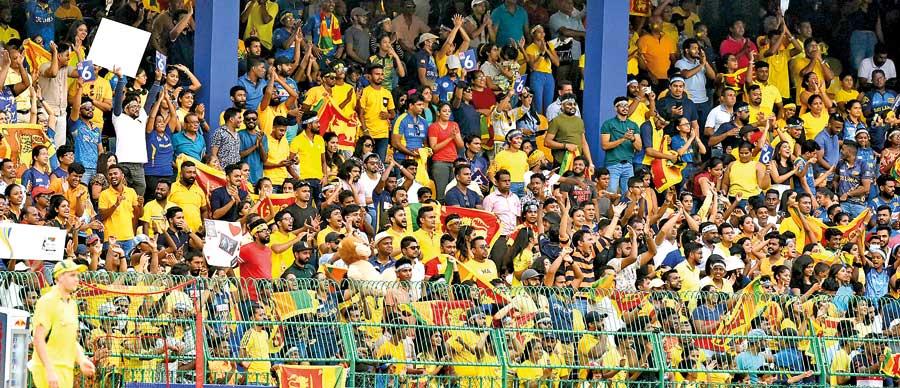27 Jun 2022 - {{hitsCtrl.values.hits}}

Local cricket fans were clad in yellow to support the Australian cricket team during last Friday’s match Pic By Kushan Pathiraja
British rock band Coldplay’s “Yellow” released on 26 June -2000 reached number four on the UK Singles Chart: they sang….
“Look at the stars”
Look how they shine for you
And everything you do
Yeah, they were all yellow
Australian cricket authorities and players responded positively to a tour that was hanging in balance after political insecurity and the economic catastrophe that prevailed. Appreciating their gesture, spectators kept their ‘blues’ in wardrobes and sported yellow on Friday; a well deserved accolade for sporting Kangaroos, ending a record five-match series victory for the Lions. The most luminous colour of the spectrum, Yellow captures our attention of happiness, optimism, enlightenment and creativity.
gesture, spectators kept their ‘blues’ in wardrobes and sported yellow on Friday; a well deserved accolade for sporting Kangaroos, ending a record five-match series victory for the Lions. The most luminous colour of the spectrum, Yellow captures our attention of happiness, optimism, enlightenment and creativity.
The ‘Tampa Bay Lightning’ is a professional ice hockey team based in Tampa, Florida, banned fans entering in opposing teams’ jerseys. Tampa imposed the rule that restricts fans from wearing opposing teams’ jerseys at Amalie Arena. However, this rule was scrapped in May 2021. The Friday’s RPS fan gesture was unique in the cricketing world!
Stones & Sticks-1882
The November 18, 1882 Ceylonese conquered Australians in a battle with sticks and stones in Bundaberg, Queensland. The Kangaroos reciprocated with Bat and Ball beating the Lions fairly and squarely in the gentlemen’s game over the decades that followed up to 1996. In the 1975 WC played in England, the Lions stunned the Cricketing world when they tore apart the terror pair, Lillie & Thomson to every nook and corner of Trent Bridge green sending Aussie fielders on a leather-hunt to score 276/4, true they lost. The first Australian cricket team that toured the island was in 1935, led by 46 year old Jack Ryder. A three-day match was played on Victoria Park’s Nomads grounds in October. Australia won by an innings and 127 runs. The next tour was in the last three months of 1969 by a team captained by Bill Lawry, both stopovers during Indian and English tours.
The Colombo Journal on September 5, 1832 carried a notice calling for the formation of a cricket club. The result was Colombo Cricket Club and matches began a year later in 1833. The first administrative body, Ceylon Cricket Association was inaugurated in 1914, and it became Board of Control for Cricket in Ceylon in 1972 in consequence to the adoption of Republican Constitution, until the present Sri Lanka Cricket came into existence in 2003. Leading political and businessmen have led the administration over the years. Some of the greats, starting from Col. Dr. John R. Rockwood, The Saravanamuttus, Robert Senanayake, Dr N M Perera, Gamini Dissanayake, Ana Punchihewa, and Neil Perera to mention a few. In the 1990s Gamini Dissanayake invited Punchihewa as a deputy to him, who later succeeded Dissanayake. Ana set up a dynamic plan to recruite Dav Whatmore and Alex Kontouri. They called for applications for a foreign coach and then Ian Botham, Alan Border, Bob Woolmer and Dav Whatmore from Australia applied. Botham wanted a million dollars! With Sri Lanka born Dav introduced scientific Australian training. At the time of signing the contract, the Board’s bank balance was Rs. 300,000/-. Punchiheva, [like our FM, had to beg from Australia] but failed. However, Dav managed to convince the Australian Cricket Board and get it. Australian generosity did not end; the guarantee money for our tour to Downunder was $100,000/-, but the ACB agreed to double it [$200,000] saying, not to make it official. Alex, the physio was costing another $ 80,000; this time Sri Lankans in Australia came to our rescue.
The 1996 World Cup
The 1996 World Cup was, in fact, hosted by 3 countries - India, Sri Lanka and Pakistan, real controversy began when it was Sri Lanka’s turn to host the matches. As per the schedule, Australia and West Indies were supposed to play their group matches against Sri Lanka on Sri Lankan soil. However, keeping in mind the security concerns, both these teams refused to travel to Sri Lanka. [Notably, a few days prior to the World Cup, LTTE had killed 90 people.] Our FM, Kadirgamar quipped ‘only sissies go shopping,’ responding to Shane Warne’s famous statement that they wouldn’t be able to do shopping. However, this was a blessing in disguise; the ICC decided to declare them winners of both the games and added bonuses elevating us to the top of the group, averting a strong possibility of not winning the WC in ’96.
Things worked well, and in March 1996, by becoming winners of the World Cup. Contrary to popular belief, Australians have supported Sri Lanka cricket in a big way. There was a false impression that the ACB was targeting Muralitharan on throwing incidents; It was definitely not the board, but a few players and umpires. At Gaddafi Stadium, Lahore on 17 March 1996, Sri Lanka was selected for their second final in World Cups in April 2007, against Aussies. Australians won by 57 runs D/L, when Gilchrist scored an incredible 149.
WC ‘75
Legendary Australian pairing –Lillee and Thomson, two of the fastest bowlers the world has ever seen launched a vicious, relentless, high-velocity assault of Lankans inflicting utmost physical and mental damage upon our batsmen. Skipper Anura Tennekoon did not expose his batsmen against Lillee and Thomson earlier in the morning and decided to field first on a placid Oval track after winning the toss.
Dennis and Jeff delivered thunderbolts but the openers, Ranjit Fernando and Sunil Wettimuny weathered the storm healthily. When Ian Chappell introduced them for a second spell, as Chappell recollect, “Two little Sri Lankans [Duleep and Sunil] were going boom, boom, boom and I said to Thommo look, these guys surely can play on the front foot, let’s see how fine they are on the back foot”. Jeff changed into a devil in his second spell. Thomson continued to bang the ball short and thudded into the body repeatedly. Wettimuny recalled, “It was like a flash. I couldn’t see the ball” – Mendis quipped, “It was the greatest spell I had ever faced; and we had no protection [no head gear then] he was firing them at top velocity” Mendis and Wettimuny’s resistance didn’t last long—Jeff hit Mendis on the head and was taken to hospital. Next he delivered a fast in-swinging yorker hitting Wettimuny’s foot badly. Wettimuny with a broken foot was admitted in the same hospital.
Sticks and Stones Match-1882 won by Lions
A ship leaving Colombo in October 1882, with a group of 480 left Colombo for Queensland and landing 275 passengers in Mackay, the rest, men skilled in various trades were taken to Bundaburg for landing on 18th November 1882-- The business of importing Lankans was labelled an invasion-- members of ACL surrounded the landing area and pelted stones at “Cingalese” with the intention of driving them back to the vessel. The landing labour force refused to surrender, instead, as eye-witness report stated, “…at a mass gathering of some 500, the president of Anti-Cooley League incited the Australians to demonstrate in a show of strength. At the port, boisterous scenes were seen which later developed into a severe confrontation between leaguers and agents of plantation companies that ordered the batch, compelling the agents to vanish from the area leaving the passengers stranded.
The abandoned immigrants numbering about 150 had no option but to react. Being forced to ‘resolve’ the situation, they gathered sticks and stones thrown at them, pulled their knives, and stormed into the human barricade of protesters making a loud and piercing cry of harsh and offensive terms both in English and Sinhala. The protesters who met with a sudden and unexpected experience in their own land suffered a rude shock and in an excessive haste, uncertainty and disorder, ran helter-skelter. The Lankans chased them away; even caused physical injury to a few who were trapped in a stampede. [Ref our col. 16/11/2015 --https://www.dailymirror.lk/95573/australian-town-badagini-named-by-sinhala-migrant-labour-in-1880s – for more]
Darrel Hair and Murali
The infamous no-balling of Muttiah Muralitharan by umpire Darrell Hair in a Test in Melbourne was likened to “a public execution” by ABC commentator Jim Maxwell. The late Australian cricketing great, leg-spinner Shane Warne was involved in relief efforts soon after the 2004 tsunami devastated us— As Daily Mirror reported last Friday, Shane’s brother Jason has stated, “Galle was one of Shane’s pet grounds and he was really upset by the destructive Tsunami.” The June 29th test series is played for the Warne-Muralitharan trophy on 29th June in Galle is dedicated to the legendary cricketer who died following a heart attack in March.
27 Nov 2024 14 minute ago
27 Nov 2024 24 minute ago
27 Nov 2024 28 minute ago
27 Nov 2024 46 minute ago
27 Nov 2024 2 hours ago